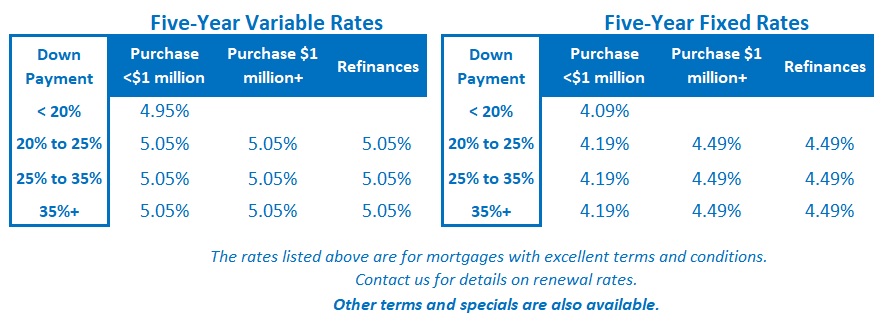Have Canadian Fixed Mortgage Rates Bottomed?
November 4, 2024A Warning About Canadian Fixed Mortgage Rates
November 18, 2024
Last week was packed with news worth noting for Canadians keeping an eye on mortgage rates.
Former US President Donald Trump won the US presidential election, and bond yields briefly spiked higher.
The US Federal Reserve cut its policy rate by 0.25% and reiterated its willingness to keep cutting if warranted. Bond-market investors responded by paring back their bets on future cuts.
Here at home, we received a so-so employment report, and Bank of Canada (BoC) Deputy Governor Carolyn Rogers gave a speech that focused on our mortgage market and included pointed words of caution for our federal government.
In today’s post, I’ll offer my take on each of these developments and close by explaining why I think our fixed and variable mortgage rates are headed in different directions.
The US Presidential Election Result
On Tuesday, former President Donald Trump conclusively won the US presidential election.
That was an unexpected result because Vice-President Kamala Harris had led in most polls, and because the general expectation was that the winner wouldn’t be finalized until well after election day.
In the immediate aftermath, bond-market investors reacted by dramatically bidding up US Treasury yields. They took Government of Canada (GoC) bond yields along for the ride. Our benchmark five-year GoC bond yield spiked higher by about 0.10% on Wednesday.
But the surge didn’t last long. By Thursday morning, bond yields had fully retraced their steps. They finished the week lower than where they started it.
A second Trump presidential term will no doubt have significant implications for bond yields, but the resulting impacts will take time to unfold.
The Fed’s 0.25% Policy-Rate Cut
Last Thursday, the Fed announced a 0.25% cut to its policy rate, lowering it to a new range between 4.50% and 4.75%.
At his accompanying press conference, US Fed Chair Jay Powell offered an assessment of the US economic backdrop that was more dovish than expected given the recent string of stronger-than-expected US economic data.
He positioned the cut as a form of insurance against weaker labour-market conditions, which he observed are now “less tight” and said that the US election “will have no effects on our policy decisions” over the near term.
The US Consumer Price Index (CPI) is now 2.3%, and the US Core Personal Consumption Expenditure (PCE) Price Index, which is the Fed’s most closely watched inflation gauge, is at 2.7%. Both measures remain above the Fed’s 2% target rate, but Powell expressed confidence that they would sustainably return to that level.
He also outlined the Fed’s plan to move its policy rate to “a more neutral stance” (where it is no longer restricting demand) when the data warrant.
The consensus estimate for the Fed’s neutral policy-rate range is 2.5% to 3%, which, even at its upper end, is 1.50% below where the Fed’s policy-rate range now stands.
For their part, US bond-market investors don’t share the Fed’s latest assessment of the current inflation backdrop, or its expectations on where rates are headed. They have pushed US Treasury yields steadily higher since mid-September and are now pricing in fewer rate cuts ahead.
Before last week, bond-market investors expected the Fed to drop its policy rate by another 1.50% by the end of 2025. But they have since reduced that to 1.00% and have slowed the expected pace of that reduction.
The Latest Canadian Employment Data (for October)
Last Friday, Statistics Canada estimated that our economy added 15,000 new jobs in October, well below the consensus forecast of 27,000.
Once again, our population growth outpaced our job creation. Our unemployment rate held steady, at 6.5%, but only because our participation rate fell from 65.6% to 64.8%. (Our participation rate measures the percentage of adult Canadians who are either working or actively looking for work.)
This report probably doesn’t move the needle much for the BoC.
The headline number was below what was expected, which would tend to make the Bank more dovish. But average hourly wage growth increased from 4.5% to 4.9%, and that will put upward pressure on inflation.
Our labour costs are rising while our productivity level is falling. That means our businesses are paying more and producing less. This trend has been evident for some time, and we won’t be able to sustain non-inflationary growth for as long as it continues.
The BoC’s Words of Caution for Our Federal Government
Last Wednesday, BoC Deputy Governor Carolyn Rogers delivered a speech at the Economic Club of Canada that focused on our mortgage market. It contained several points of note:
- Rogers acknowledged the coming “mortgage renewal wall” that is in store over the next two years, when “about 60% of our outstanding mortgages” will renew, including “a big portion … [which] have not renewed since interest rates started rising in 2022.”
- The Deputy Governor expressed confidence that Canadians “will continue to adjust their saving and spending patterns to absorb the impact of higher mortgage payments”.
- She noted that “Canadians have a long history of paying their mortgages”; she observed that our mortgage arrears rate never rose above 0.50% during the global financial crisis of 2008/2009; and she assessed that our mortgage market has “fared well” through the recent “sharp rise in interest rates”.
- She cautioned our federal government against “the temptation to try to solve the housing affordability challenge by tinkering too much with the mortgage market”. The timing of that advice was noteworthy given their recent decisions to do just that.
- She more specifically warned that “leaning too much on measures that reduce the short-term cost of financing could have long-term impacts on the financial health of households, the mortgage market, and the economy.”
Amen to that.
Why Our Fixed and Variable Mortgage Rates Are Now Likely Headed in Different Directions
There is near universal consensus that the BoC will continue to reduce its policy rate from its current level of 3.75% over the near term.
Now that inflation has fallen back to its 2% target, there is no reason to maintain tight monetary-policy conditions to restrict demand. Our economy can use all the help it can get at this time, and the Bank’s policy rate will remain unsuitably restrictive until it is reduced to a range between 2.50% and 3.00%.
For that reason, if you’re a variable-rate borrower, I think it is reasonable to expect your rate to drop by at least another 1% from its current level during this rate-cut cycle.
I anticipate that fixed rates will follow a different near-term path.
If rates haven’t bottomed out yet, for the reasons I outlined in last week’s post, I believe they will do so soon.
For starters, the BoC’s expected rate cuts are now fully priced into the GoC bond yields, which our fixed mortgage rates are priced on. The benefit from Canadian inflation’s return to target is also now reflected in their current levels.
At the same time, the strong gravitational pull from US Treasuries is exerting upward pressure.
A lot of folks are still expecting a big move down in fixed rates as the BoC continues to cut its policy rate.
I think there is a good chance that they will be disappointed. The Bottom Line: GoC bond yields were on a roller-coaster ride last week. When the dust settled at the close of business on Friday, they had finished just a little lower than where they started.
The Bottom Line: GoC bond yields were on a roller-coaster ride last week. When the dust settled at the close of business on Friday, they had finished just a little lower than where they started.
Fixed mortgage rates are holding steady for now, but I think that last week confirmed that bond-market investors on both sides of the 49th parallel are increasingly concerned about the upside risks to their forecasts.
I don’t think last week’s developments will alter the BoC’s near-term plans to continue cutting its policy rate. That is good news for variable-rate borrowers.
For the reasons outlined above, I think our fixed and variable mortgage rates may be about to move in opposite directions.







